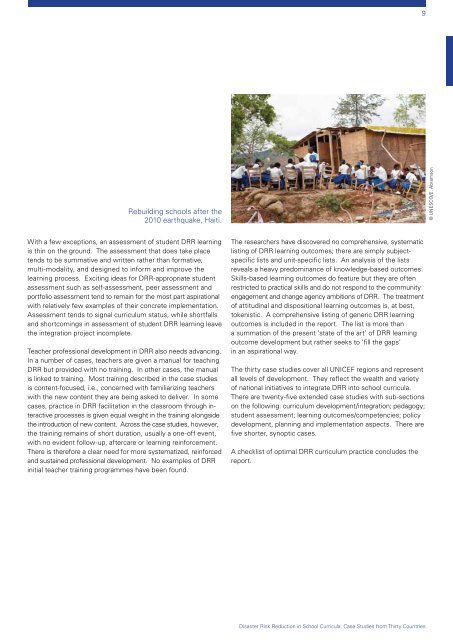Disaster Risk Reduction in School Curricula: Case Studies ... - Unicef
Disaster Risk Reduction in School Curricula: Case Studies ... - Unicef
Disaster Risk Reduction in School Curricula: Case Studies ... - Unicef
Create successful ePaper yourself
Turn your PDF publications into a flip-book with our unique Google optimized e-Paper software.
9<br />
Rebuild<strong>in</strong>g schools after the<br />
2010 earthquake, Haiti.<br />
© UNESCO/E. Abramson<br />
With a few exceptions, an assessment of student DRR learn<strong>in</strong>g<br />
is th<strong>in</strong> on the ground. The assessment that does take place<br />
tends to be summative and written rather than formative,<br />
multi-modality, and designed to <strong>in</strong>form and improve the<br />
learn<strong>in</strong>g process. Excit<strong>in</strong>g ideas for DRR-appropriate student<br />
assessment such as self-assessment, peer assessment and<br />
portfolio assessment tend to rema<strong>in</strong> for the most part aspirational<br />
with relatively few examples of their concrete implementation.<br />
Assessment tends to signal curriculum status, while shortfalls<br />
and shortcom<strong>in</strong>gs <strong>in</strong> assessment of student DRR learn<strong>in</strong>g leave<br />
the <strong>in</strong>tegration project <strong>in</strong>complete.<br />
Teacher professional development <strong>in</strong> DRR also needs advanc<strong>in</strong>g.<br />
In a number of cases, teachers are given a manual for teach<strong>in</strong>g<br />
DRR but provided with no tra<strong>in</strong><strong>in</strong>g. In other cases, the manual<br />
is l<strong>in</strong>ked to tra<strong>in</strong><strong>in</strong>g. Most tra<strong>in</strong><strong>in</strong>g described <strong>in</strong> the case studies<br />
is content-focused, i.e., concerned with familiariz<strong>in</strong>g teachers<br />
with the new content they are be<strong>in</strong>g asked to deliver. In some<br />
cases, practice <strong>in</strong> DRR facilitation <strong>in</strong> the classroom through <strong>in</strong>teractive<br />
processes is given equal weight <strong>in</strong> the tra<strong>in</strong><strong>in</strong>g alongside<br />
the <strong>in</strong>troduction of new content. Across the case studies, however,<br />
the tra<strong>in</strong><strong>in</strong>g rema<strong>in</strong>s of short duration, usually a one-off event,<br />
with no evident follow-up, aftercare or learn<strong>in</strong>g re<strong>in</strong>forcement.<br />
There is therefore a clear need for more systematized, re<strong>in</strong>forced<br />
and susta<strong>in</strong>ed professional development. No examples of DRR<br />
<strong>in</strong>itial teacher tra<strong>in</strong><strong>in</strong>g programmes have been found.<br />
The researchers have discovered no comprehensive, systematic<br />
list<strong>in</strong>g of DRR learn<strong>in</strong>g outcomes; there are simply subjectspecific<br />
lists and unit-specific lists. An analysis of the lists<br />
reveals a heavy predom<strong>in</strong>ance of knowledge-based outcomes.<br />
Skills-based learn<strong>in</strong>g outcomes do feature but they are often<br />
restricted to practical skills and do not respond to the community<br />
engagement and change agency ambitions of DRR. The treatment<br />
of attitud<strong>in</strong>al and dispositional learn<strong>in</strong>g outcomes is, at best,<br />
tokenistic. A comprehensive list<strong>in</strong>g of generic DRR learn<strong>in</strong>g<br />
outcomes is <strong>in</strong>cluded <strong>in</strong> the report. The list is more than<br />
a summation of the present ‘state of the art’ of DRR learn<strong>in</strong>g<br />
outcome development but rather seeks to ‘fill the gaps’<br />
<strong>in</strong> an aspirational way.<br />
The thirty case studies cover all UNICEF regions and represent<br />
all levels of development. They reflect the wealth and variety<br />
of national <strong>in</strong>itiatives to <strong>in</strong>tegrate DRR <strong>in</strong>to school curricula.<br />
There are twenty-five extended case studies with sub-sections<br />
on the follow<strong>in</strong>g: curriculum development/<strong>in</strong>tegration; pedagogy;<br />
student assessment; learn<strong>in</strong>g outcomes/competencies; policy<br />
development, plann<strong>in</strong>g and implementation aspects. There are<br />
five shorter, synoptic cases.<br />
A checklist of optimal DRR curriculum practice concludes the<br />
report.<br />
<strong>Disaster</strong> <strong>Risk</strong> <strong>Reduction</strong> <strong>in</strong> <strong>School</strong> <strong>Curricula</strong>: <strong>Case</strong> <strong>Studies</strong> from Thirty Countries

















